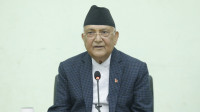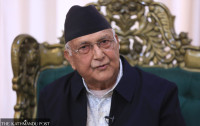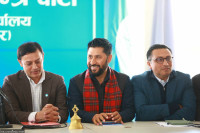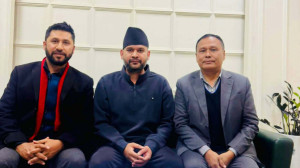Politics
Bhattarai raps Yadav at a factional meeting as split looms in Janata Samajbadi Party
Bhattarai faction held a central committee plenum in Kathmandu on Tuesday as Yadav prepares for a similar meeting in Birgunj Wednesday.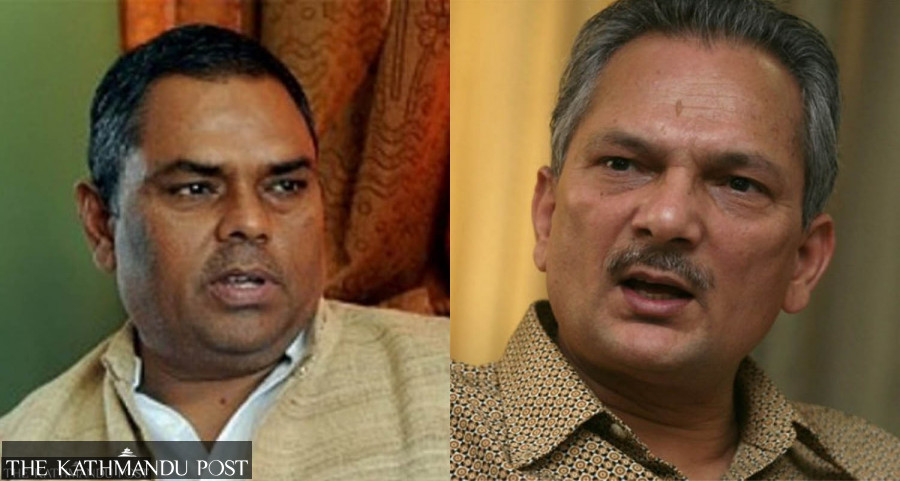
Prithvi Man Shrestha
The Janata Samajbadi Party, which was launched nearly two years ago with an aim to become a promising alternative to the traditional political parties, is once again on the brink of yet another split.
The party had suffered a split in July last year after a faction led by Mahantha Thakur formed the Lokantrik Samajbadi Party.
A new split is imminent with the party’s feuding factions led by Baburam Bhattarai and Upendra Yadav calling separate gatherings of their supporters.
The Bhattarai faction organised a ‘plenum’ of the central committee in Kathmandu on Tuesday which will last till Wednesday while the Yadav faction has scheduled a similar ‘plenum’ in Birgunj for Wednesday and Thursday.
Presenting his political paper at the Kathmandu gathering on Tuesday, Bhattarai, who is the chairperson of the party’s federal council, admitted that the party failed to emerge as a national political force and an alternative to the traditional parties and communist forces, but was confined to the Tarai. He blamed the situation on the party’s lack of efforts to expand organisation nationwide.
“The approach to party building was oriented towards limiting the party to a regional force. The main leadership didn’t show a strong will towards making united efforts to expand the party organisation to other parts and provinces,” Bhattarai said, pointing out the tendency of Yadav, who is another chairperson of the party, heading the central committee.
He blamed the Yadav faction for pouring cold water on the efforts to make the party a national alternative, which can connect the mountains, hills and the Tarai-Madhes through an inclusive leadership.
Bhattarai’s assertion that the party failed to become a national political force was justified by the Janata Samajbadi Party’s failure to win local units in hill districts in the May 13 local elections.
The party won a total of 30 local unit chiefs and 31 deputy chiefs, mostly in the Tarai, while the Nepali Congress, the CPN-UML and the CPN (Maoist Centre) once again emerged as three largest parties with significantly higher number of seats in the local elections.
Mahendra Rai Yadav, a leader close to Bhattarai, echoed Bhattarai.
The party’s possibility of emerging as an alternative political force remains only if it remains united. “We organised a separate gathering after the other faction scheduled a meeting in Birgunj without notifying us,” Yadav said. “We are not in favour of a split, and whether the party remains united or not depends entirely on the other faction.”
Leaders and political observers say the long-running factionalism and disputes in the party are preventing it from developing into an alternative force.
Devendra Paudel, who had defected to the Maoist Centre from Bhattarai’s Naya Shakti Party in 2017, said Bhattarai’s attempts to create an alternative political force have not been successful owing to his lack of foundation for the same.
“There is a need for a foundation, ideology, specific goals and a movement to establish an alternative political force,” said Paudel, who is also the education minister.
“In India, the Aam Aadmi Party emerged from the anti-corruption movement launched by Anna Hazare. But Bhattarai tried to create an alternative force without any foundation and so he failed.”
Paudel, who had helped Bhattarai to form the Naya Shakti Party ‘because of his close relations with Bhattarai,’ compared Bhattarai’s failures to that of Rabindra Mishra, who recently resigned as chairperson of the Bibeksheel Sajha Party after the party’s disastrous performance in the May 13 local elections.
Tula Narayan Shah, a political observer and writer who follows Madhes politics closely, said the Janata Samajbadi Party had an opportunity to expand its organisation across the country, but it squandered the chance by failing to make a collective effort towards that end.
“Had top leaders like Bhattarai, Yadav and Ashok Rai made collective efforts, the party had good prospects for orgainsational growth across regions,” said Shah.
“Instead, Yadav didn’t want to give Bhattarai an equal status in the leadership by reasoning that the party’s vote base is in Madhes. And this created an uncomfortable situation for Bhattarai leading to the current situation in the party.”
According to Shah, Bhattarai didn’t have enough votes in the hilly regions which are dominated by traditional parties and it was not his fault. “The leaders failed to make collective efforts to expand the party’s organisation in hill districts despite their stated objective being to become an alternative political force,” said Shah.
With the party now on the verge of a split, it will be even more difficult for Bhattarai to pursue his objective, according to political observers.
Bhattarai had written several articles in newspapers and magazines about the need for an alternative force in Nepali politics before he launched the Naya Shakti Party in January 2016. Bhattarai, a leader of the decade-long Maoist insurgency, parted ways with the then UCPN (Maoist) in September 2015 days after the promulgation of the constitution, to form the Naya Shakti Party.
Mumaram Khanal, a political analyst who worked closely with Bhattarai during the insurgency and later in the early days of the Naya Shakti Party, said Bhattarai’s efforts to create an alternative force have failed because he is not a new face, so people do not trust him.
“When he formed the Naya Shakti Party, he brought the leaders and cadres from the Maoist party and their working style forced out many new faces,” Khanal, who was one of the founding leaders of Naya Shakti Party, said. “Later, many of the leaders returned to the mother party which made Bhattarai more or less alone, forcing him to join hands with Yadav.”
Khanal himself had left the Naya Shakti Party in October 2016.
The party performed poorly in the elections in 2017. In 2019, Bhattarai’s Naya Shakti Party and Yadav’s Sanghiya Samajwadi Party Forum merged to become the Samajbadi Party Nepal.
Leaders at that time had said that the merger was necessitated by an apparent lack of a “strong third force” and that the Samajbadi Party Nepal would strive to create an “alternative force” in the country.
The current Janata Samajbadi Party was formed in April 2020 after the Bhattarai-Yadav-led Samajbadi Party Nepal merged with the Rastriya Janata Party.
“Regional or ethnicity-based parties cannot become a national alternative,” said Khanal. “I don’t think he will be able to build an alternative force now also because he is already too old for that.”
Bhattarai has a long legacy in the Maoist movement and there is also a possibility of him collaborating with his longtime comrade Maoist Centre chief Pushpa Kamal Dahal.
Only recently, Dahal and Bhattarai had held a meeting at the residence of Vice President Nanda Bahadur Pun to discuss the possibility of creating a new political outfit by bringing together all former Maoists.
“If they worked together, then the Maoist Centre itself can develop as an alternative force,” said Paudel, the Maoist Centre leader. “And the name of the party and its working style can be changed. But for that, Bhattarai should give up his prejudices about the Maoist party.”




 5.17°C Kathmandu
5.17°C Kathmandu
